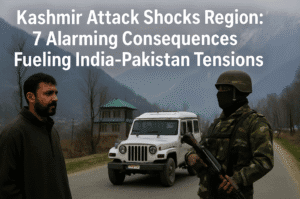Kashmir Attack Shocks Region: 7 Alarming Consequences Fueling India-Pakistan Tensions
The deadly attack on Hindu tourists in Kashmir’s Pahalgam valley, which killed 26 civilians, has reignited decades-old tensions between India and Pakistan, exposing the fragility of New Delhi’s security claims in the disputed region. India retaliated by suspending its share of the 1960 Indus Waters Treaty—a lifeline for Pakistan’s agriculture—closing key borders, expelling Pakistani diplomats, and hinting at military action, echoing its 2019 response to a similar crisis.
The assault, blamed on Pakistan-backed militants (though denied by Islamabad), underscores unresolved grievances in Kashmir, where India’s 2019 revocation of autonomy failed to quell unrest. Survivors’ accounts of targeted killings evoke traumatic memories of 1990s violence, shaking public confidence in government assurances of stability. As tourists flee and Kashmir’s economy reels, Prime Minister Modi faces mounting pressure to balance retaliatory measures with avoiding full-scale conflict, complicated by China’s encroachment on India’s northern border.
Analysts warn that heavy-handed security without addressing political alienation risks perpetuating cycles of violence. With both nuclear-armed nations entrenched in historical distrust, the attack underscores the urgent need for dialogue over escalation to address the human cost of a conflict rooted in partition-era divisions.

Kashmir Attack Shocks Region: 7 Alarming Consequences Fueling India-Pakistan Tensions
The recent massacre of 26 civilians, predominantly Hindu tourists, in Kashmir’s idyllic Pahalgam valley has reignited long-simmering tensions between India and Pakistan, threatening to destabilize a region already fraught with historical grievances and nuclear brinkmanship. As India unveils retaliatory measures—including suspending a critical water-sharing pact and expelling Pakistani diplomats—the attack exposes the fragility of New Delhi’s security narrative in Kashmir and raises urgent questions about the path forward.
The Attack and Its Immediate Fallout
On Tuesday, militants targeted a tourist group picnicking near Pahalgam, a region marketed as a symbol of Kashmir’s restored peace post-2019. Survivors recounted harrowing scenes of gunmen methodically identifying Hindu victims, echoing 1990s-era violence that once drove thousands of Kashmiri Pandits from the valley. The assault not only shattered families but also punctured the Indian government’s claim that its 2019 revocation of Kashmir’s autonomy had quelled militancy.
India’s swift retaliation—halting its participation in the 1960 Indus Waters Treaty, closing key borders, and restricting visas—signals a hardening stance. Defense Minister Rajnath Singh’s vow to pursue “actors behind the scenes” hints at potential military action, evoking memories of the 2019 Balakot airstrikes following a similar attack.
Historical Context: A Cycle of Violence and Diplomacy
The Kashmir conflict, rooted in the 1947 partition, has seen decades of proxy warfare, with India accusing Pakistan of backing groups like Lashkar-e-Taiba. Pakistan denies involvement, attributing the violence to “homegrown” discontent. Notably, the attack coincides with Pakistani Army Chief General Asim Munir’s recent proclamation of Kashmir as Pakistan’s “jugular vein,” a rhetoric that Indian analysts view as incendiary.
The 2019 revocation of Article 370, which stripped Kashmir’s autonomy, was framed by Prime Minister Narendra Modi as a move to integrate the region and curb terrorism. However, Tuesday’s attack underscores the limitations of heavy-handed security measures without addressing underlying grievances, such as political disenfranchisement and unemployment.
Human Toll and Political Pressure
The victims’ stories reveal the attack’s deeply personal impact. Kaustubh Gunbote, a shop owner from Pune, was killed in front of his wife, who described the assailants’ chilling calm. Families nationwide now question the government’s assurances of safety, while Kashmiri businesses face renewed economic fallout as tourists flee.
For Modi, the attack poses a dual challenge: maintaining his strongman image ahead of elections while avoiding escalation into full-scale war. His administration’s reliance on tourism as a sign of normalcy now appears tragically naive, with opposition leaders like Omar Abdullah lamenting the “exodus of guests” from the valley.
Geopolitical Implications
India’s suspension of the Indus Waters Treaty marks a significant escalation. The treaty, which allocates river resources between the two nations, is a lifeline for Pakistan’s agriculture. While Modi previously threatened “water wars” in 2016, this formal suspension could devastate Pakistan’s economy and inflame cross-border hostility.
Meanwhile, China’s encroachment in Ladakh complicates India’s security calculus. With troops recently disengaging after a four-year standoff, New Delhi risks diverting resources from its northern border to address Kashmir, potentially emboldening Beijing.
Expert Insights: A Flawed Strategy?
Retired General D.S. Hooda notes the attack deliberately targets India’s narrative of control. “The government’s approach has been to equate security with normalization,” he says. “But without addressing political alienation, militancy will persist.”
Security analysts suggest the involvement of newer groups like the Resistance Front, allegedly a proxy for Pakistan-based militants, reflects evolving tactics to bypass international scrutiny. However, without concrete evidence linking Pakistan directly to the attack, India’s punitive measures risk appearing reactionary.
The Road Ahead
As Pakistan convenes its National Security Committee, both nations tread a precarious line. Historical precedents—like the 2001 Parliament attack or the 2019 Pulwama crisis—show that public outrage often drives swift retaliation, but lasting solutions require dialogue.
For Kashmiris, caught between militancy and militarization, the attack underscores a bleak reality: until their political aspirations are acknowledged, cycles of violence will persist. As funerals conclude and rhetoric intensifies, the region’s future hinges on whether India and Pakistan can transcend tit-for-tat measures to address the conflict’s root causes.
In the shadow of nuclear arsenals and geopolitical rivalries, the Pahalgam massacre is more than a tragedy—it’s a stark reminder of the human cost of unresolved history.
You must be logged in to post a comment.